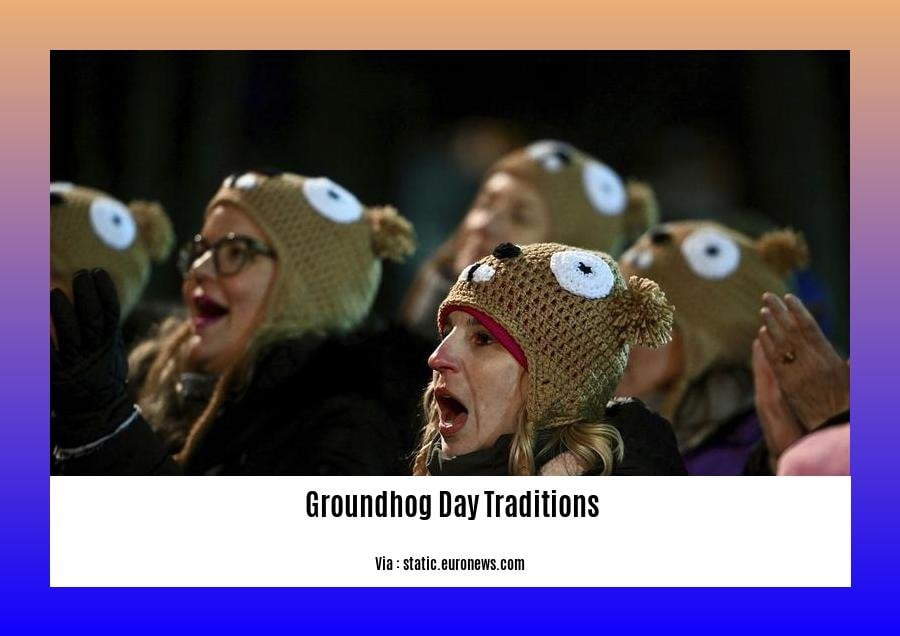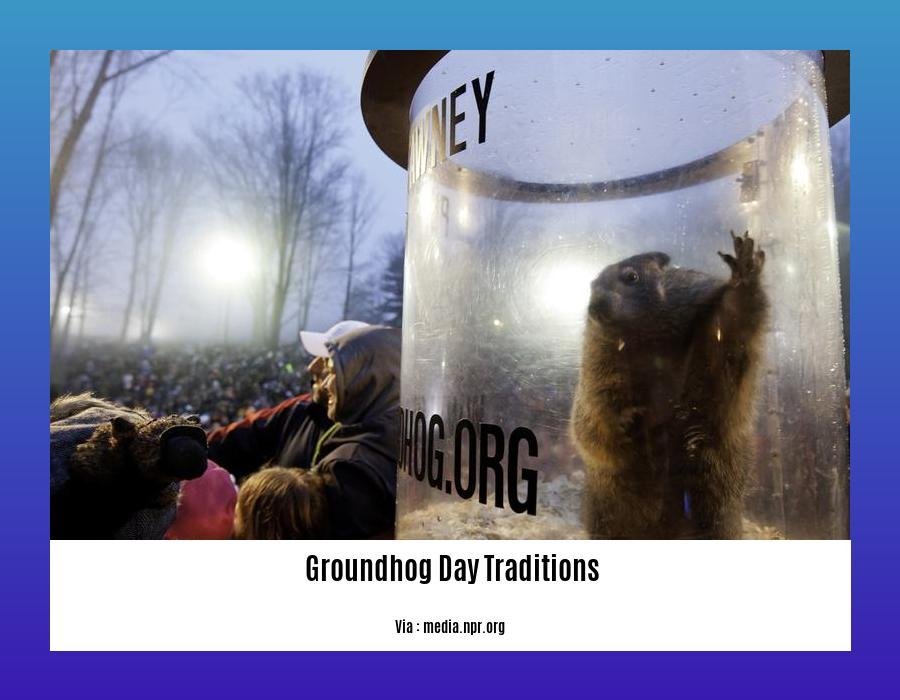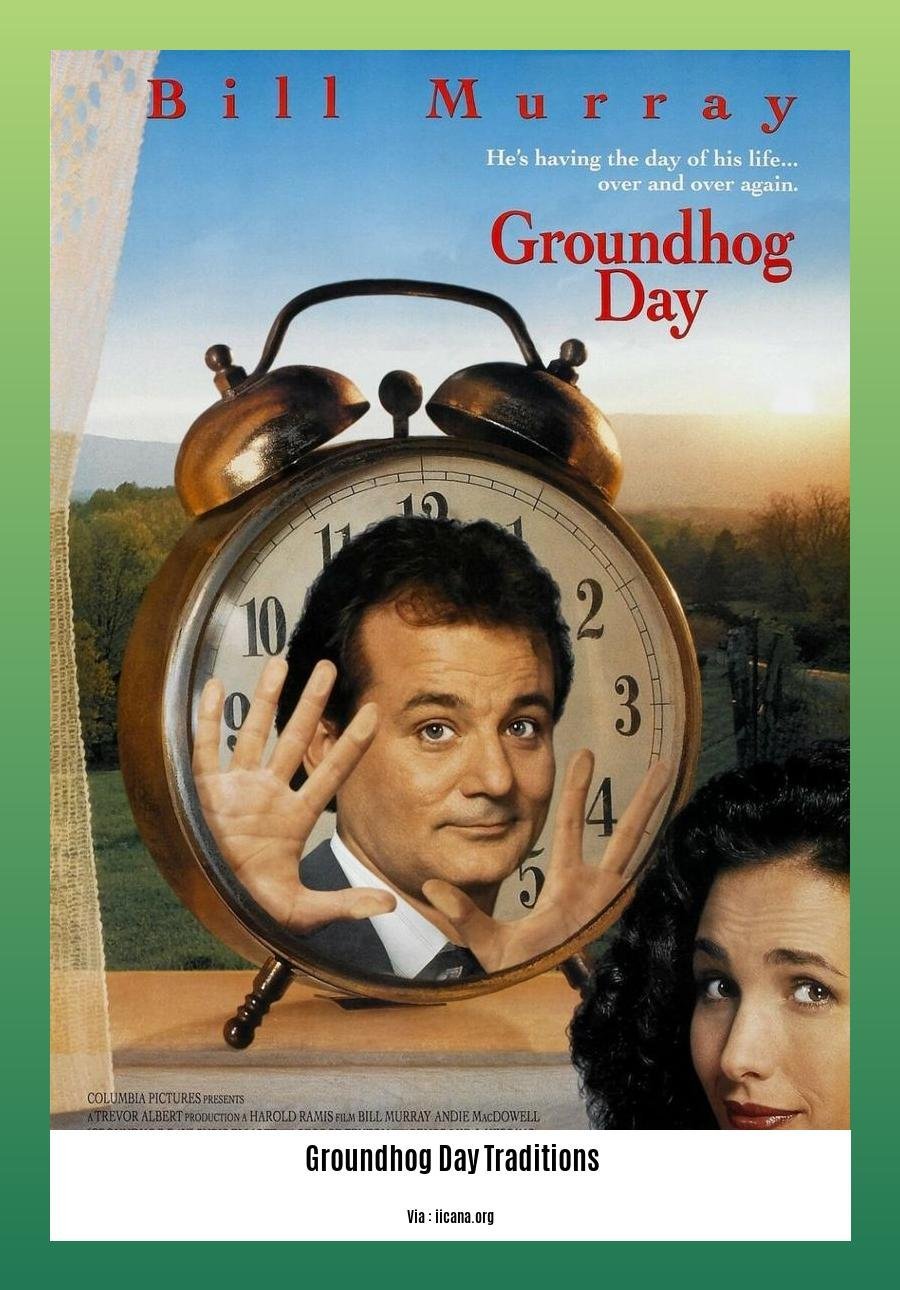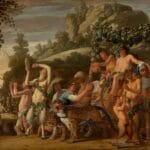Embark on a captivating exploration into the rich tapestry of Groundhog Day traditions in [Unveiling the Tapestry of Groundhog Day Traditions]. Join us as we unravel the intricate web of customs, folklore, and cultural beliefs that have shaped this intriguing mid-winter celebration across continents.
Key Takeaways:
- Groundhog Day has roots in Candlemas, a Christian tradition involving distributing blessed candles.
- Germans linked weather prediction to hedgehogs, which later became groundhogs.
- Punxsutawney, Pennsylvania holds a famous Groundhog Day celebration.
- Bill Murray’s film “Groundhog Day” boosted the event’s popularity.
- Celebrations include attending festivals, watching the film, making Groundhog Stew, and hosting look-alike parties.
Groundhog Day Traditions

Prepare to dive into the fascinating world of Groundhog Day traditions as we explore their historical roots, symbolic meanings, and diverse celebrations across cultures!
Origins and Evolution
Groundhog Day stems from the Christian festival of Candlemas, where blessed candles symbolized hope during winter’s darkness. German immigrants brought the custom of using a hedgehog, later replaced by the groundhog, to predict the weather.
Punxsutawney’s Groundhog Day Fame
Punxsutawney, Pennsylvania, has become synonymous with Groundhog Day traditions. On February 2nd, crowds gather to witness Punxsutawney Phil emerge from his burrow, and his prediction on the duration of winter is met with either cheers or groans.
Beyond Punxsutawney
Groundhog Day traditions extend far beyond Punxsutawney.
- Attend Celebrations: Join festivities in towns like Marietta, Ohio, and French Lick, Indiana, where parades and live music accompany the groundhog’s forecast.
- Movie Night: Cuddle up with Bill Murray’s classic film “Groundhog Day,” enjoying its humorous take on the tradition.
- Sing-Alongs: Belt out the lively Groundhog Day Song, a staple of the holiday’s cheer.
- Look-Alike Parties: Gather with friends dressed as groundhogs for a touch of whimsy.
- Culinary Delights: Savor groundhog stew, a traditional dish on February 2nd. Or, indulge in “Dirt Pie,” a chocolate dessert evoking the groundhog’s burrow.
Cultural Interpretations
Groundhog Day traditions vary around the globe.
| Country | Animal | Interpretation |
|---|---|---|
| US | Groundhog | Predicts the duration of winter |
| Germany | Badger | Symbolizes good luck |
| Scotland | Hedgehog | Foretells a mild or severe winter |
From forecasting the weather to invoking prosperity, Groundhog Day traditions have become an integral part of many cultures, reminding us of the anticipation and hope associated with the end of winter.
To delve deeper into the origins of this fascinating tradition, explore the history of Groundhog Day, tracing its roots back to ancient cultures and folklore. Discover the legendary Punxsutawney Phil’s predictions throughout the years, uncovering the curious and often-debated accuracy of his forecasts. Embark on a historical journey by exploring the German origins of Groundhog Day, understanding the traditions and beliefs that have shaped this beloved holiday.
The Symbolic Significance of the Groundhog

The groundhog, a fascinating creature known for its burrowing abilities and hibernation patterns, holds symbolic significance in various cultures:
- Earth-Sky Connection: Groundhogs’ ability to navigate between the earth and the sky symbolizes their connection to both the physical and spiritual realms.
- Balance and Harmony: The alternating periods of hibernation and activity represent the inherent balance within nature, as well as the cyclical nature of life.
- Life-Death-Rebirth Cycle: The groundhog’s hibernation and emergence mirror the cycle of death and rebirth, a symbol of renewal and hope.
- Luck and Prosperity: Spotting a groundhog is often seen as an omen of good fortune and abundance.
In the context of Groundhog Day, the groundhog’s behavior is believed to hold predictive power:
- Weather Forecasting: If the groundhog sees its shadow on Groundhog Day (February 2nd), it foretells six more weeks of winter; if it doesn’t, spring is said to arrive early.
- Cultural Symbolism: The groundhog has become a beloved symbol of Groundhog Day, representing the hope and anticipation of spring’s arrival.
Key Takeaways:
- The groundhog symbolizes the connection between earth and sky, balance in nature, and the cycle of life.
- In Groundhog Day traditions, the groundhog’s behavior is believed to predict the duration of winter.
- The groundhog has become an iconic symbol of hope and the anticipation of spring.
Relevant URL Sources:
- Groundhog Symbolism & Meaning – Symbolopedia:
- Groundhog Day: Ancient Origins of a Modern Celebration | Folklife Today:
Modern Interpretations and Celebrations
Groundhog Day continues to captivate in modern times, with Modern Interpretations and Celebrations that weave together tradition and contemporary flair. Across the globe, communities infuse the day with unique flavors, reflecting the diversity of cultural expression.
Metaphorical Interpretations:
- The groundhog emerges from its burrow like a symbol of hope and the promise of brighter days ahead.
- Its shadow, if seen, represents the lingering challenges and uncertainties that winter brings.
Community Events:
- Parades, festivals, and local gatherings celebrate the day with music, dance, and street performances.
- “Groundhog Day” parties embrace the movie’s iconic time loop, encouraging participants to relive the same day over and over.
Creative Expressions:
- Artists create paintings, sculptures, and other works inspired by the groundhog and its significance.
- Groundhog-themed food and drinks add a playful touch to the festivities.
Customized Celebrations:
- Schools and youth groups use the day as an opportunity to teach about hibernation, weather, and folklore.
- Businesses host special promotions or events to commemorate the tradition.
Cultural Fusion:
- In some regions, Groundhog Day blends with local customs, such as the Chinese Dragon Boat Festival or the Mexican Day of the Dead.
- The groundhog’s role as a weather predictor has also influenced other cultures around the world.
Key Takeaways:
- Groundhog Day embodies modern interpretations that intertwine tradition, creativity, and community.
- Contemporary celebrations range from parades and festivals to artistic expressions and customized events.
- The groundhog’s symbolism resonates with hope, resilience, and the changing seasons.
- The day fosters a sense of belonging, encourages reflection, and connects cultures through shared traditions.
Relevant Sources:
- Groundhog Day: Ancient Origins of a Modern Celebration | Folklife Today
- Groundhog Symbolism & Meaning – Symbolopedia
Cultural Impact and Legacy of Groundhog Day
Key Takeaways:
- Ancient Origins: Groundhog Day stems from ancient Celtic and Germanic beliefs tied to divination and weather prediction.
- Symbolic Nature: The groundhog represents balance, life-death-rebirth cycles, and earth-sky connections.
- Modern Celebrations: Groundhog Day continues in the US and Canada, often with humor and symbolic proclamations.
- Cultural Impact: The groundhog has become an American icon associated with waiting for spring’s arrival.
- Spring Promise: According to folklore, if the groundhog doesn’t see its shadow, it signifies the nearing of spring.
Groundhog Day, a tradition steeped in folklore, has left a significant cultural impact and legacy. Its origins, rooted in ancient cross-quarter day practices, link it to the rhythms of nature and the changing of seasons.
Over the centuries, the groundhog has emerged as a symbolic creature, embodying:
- Balance: Its alternating hibernation and activity represent the cyclical nature of life and the world around us.
- Life-Death-Rebirth: Hibernation and emergence mirror the journey of death and rebirth, echoing seasonal changes.
- Earth-Sky Connection: Its ability to burrow underground and roam above ground symbolizes its connection to both realms.
In modern times, Groundhog Day remains a beloved event, celebrated with parades, songs, and the famous prognostication by Punxsutawney Phil. Its humorous and lighthearted nature reminds us of the anticipation and hope associated with the arrival of spring.
Cultural Impact
The Cultural Impact and Legacy of Groundhog Day is evident in its enduring popularity and widespread recognition:
- American Symbol: The groundhog has become an iconic symbol of American culture, associated with our collective yearning for the end of winter’s grasp.
- Spring’s Promise: According to folklore, if the groundhog doesn’t see its shadow, it signifies the nearing of spring, bringing hope and optimism.
- Popular Culture: Groundhog Day has been featured in numerous films, TV shows, and books, further solidifying its place in our cultural consciousness.
Relevant URL Sources:
– Groundhog Symbolism & Meaning – Symbolopedia
– Groundhog Day: Ancient Origins of a Modern Celebration





![[Facts about Germany culture]: Unveiling the Rich Tapestry of German Traditions and Heritage Facts-about-Germany-culture_2](https://www.lolaapp.com/wp-content/uploads/2023/12/Facts-about-Germany-culture_2-150x150.jpg)






